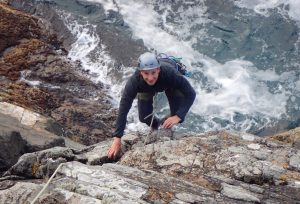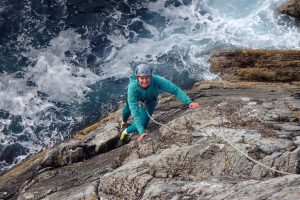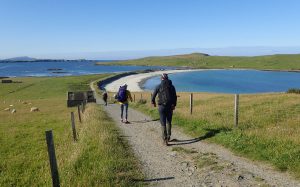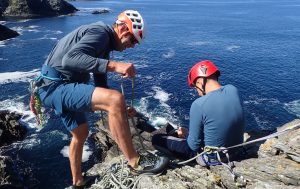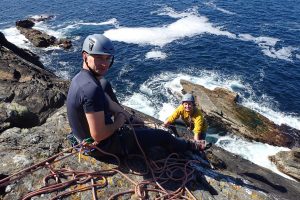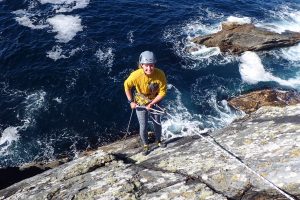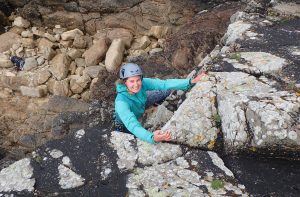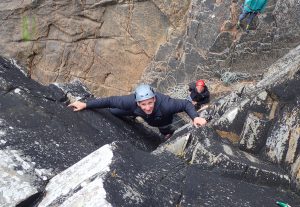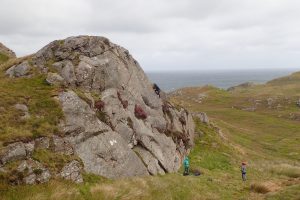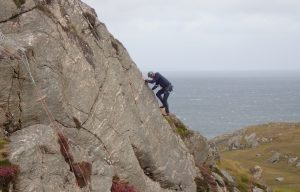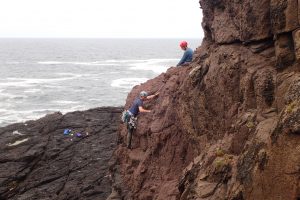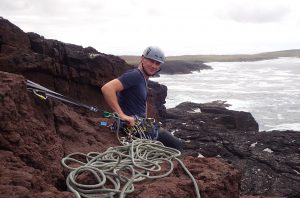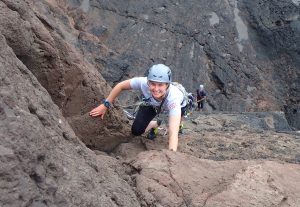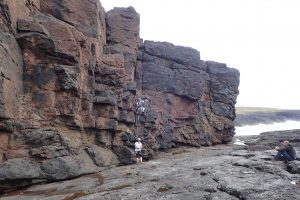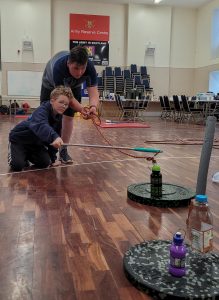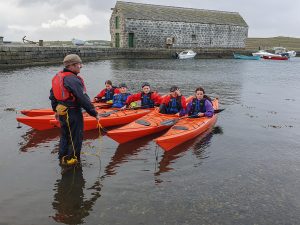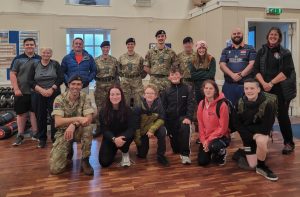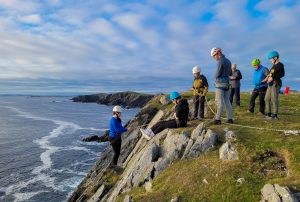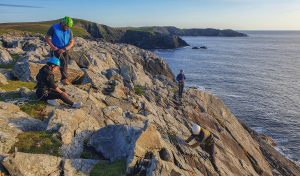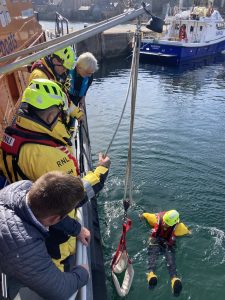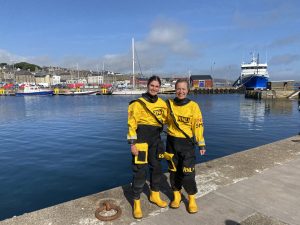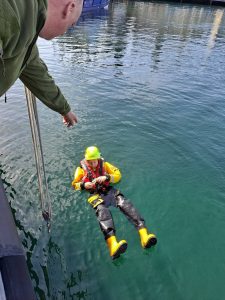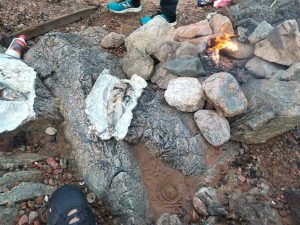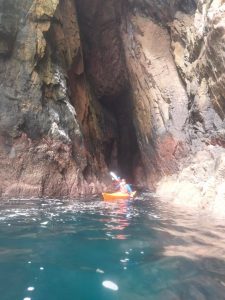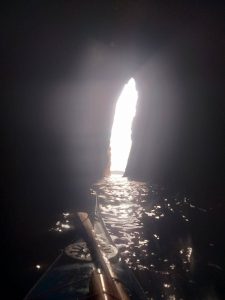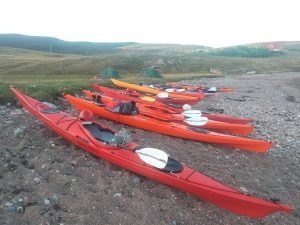Over the course of a week in August, 105 Regiment Royal Artillery (The Scottish and Ulster Gunners) and Exeter Officers’ Training Corps deployed to the Shetland Islands on Ex Tammie Norrie, an Adventurous Training (AT) expedition. Over the seven days, the three groups aimed to achieve one of the following qualifications; Rock Climbing Foundation Course (RCF), Kayak Foundation Course (K2F), which was conducted in a sea kayak, and an Intermediate Sea Kayaking Foundation Course (S3N). The groups consisted of 12 Army Reservists, 7 officer cadets from Exeter University Officer Training Corps and 2 Regular Army instructors loaned from other units. The activities were progressive in nature, giving individuals the foundation skills to develop more technically demanding aspects of each sport on further AT courses and/or in own time by themselves and with friends/family.
For the climbing group, there were three students under the direction of the exercise’s leader Lt Col Huw Gilbert, which allowed for lessons and climbs to run smoothly and efficiently the whole week. The aim of the course was to follow a “learn to lead” type syllabus, learning techniques required to lead, from climbing body positioning to effective ropework to selection and placement of gear. After spending the morning of arrival on the overnight ferry, the group went straight onto the cliffs. The first days, Sunday and Monday, were spent on climbs based on Bannaminn Crag, situated on the west coast of Burra. This location was used to build confidence and familiarisation of rock environment through gaining mileage up the many routes on offer. With the number of students, it was possible to teach a skill as a trio then split into pairs for the climbing, allowing sufficient practice and queries to occur. They took turns building anchors, abseiling down to the bottom of a crag to gain sea level ledges/bases to then climb back up. Over the course of the two days, the routes explored were; ‘Fading Sun’ (V Difficult), ‘Slab and Tickle’ (V Difficult), ‘Winterwadder’ (V Difficult), ‘Tired and Awake’ (Severe, 4c), ‘Central Slab’ (Severe), ‘Wee Nip’ (Severe, 4a) and ‘Open Book’ (Severe, 4a).
Having covered key components and to counter a north westerly wind on Tuesday, the group took the ferry across to the island of Bressay for the east facing crag, ‘Muckle Hell.’ Here the group was introduced to lead climbing, a technique where a lead climber clips the rope into fixed climbing gear in the rock (sometimes with slings/runners attached) while the second climber belays the rope up at the base of the climb and protects the lead climber in the event of a fall. Gently angled and broken slabs beside the main routes allowed for students to trail ropes up and place gear before incorporating the previous days’ skill of anchors at the top to then guide each other up their made-up routes. Gear with runners was pre-placed to allow for students to climb with ease due to the routes being, though suitably graded, a bit tricky for a first lead. All were able to demonstrate comfortable and sufficient skills by the end, especially when bringing up the second climber, despite the changing, cold winds at the top. The routes climbed were ‘Ramp Up’ (V Difficult), ‘Crocodile Corner, (Severe) and an unlisted one left of ‘Ramp Up.’
On Wednesday the wind increased, but they were able to find sufficient shelter on an inland crag tucked on an east facing hillside at Lunning, known as ‘Scotch Rock’. This was used as an opportunity to teach setting up bottom rope systems to create four routes and assisted hoists so that the team was prepared for the case of a climber being unable to continue and/or becoming tired on future harder routes and needed to be “hoisted” up the rest of the cliff.
The team headed out to the gorgeous headland of Eshaness on Thursday with the intention of climbing Tingon. Unfortunately, despite the bright sunshine, the sea swell made access to ledges restricted; however, they found success at South Gill Crag, just north of the headland and above the sea. They climbed one route listed in the guidebook, ‘Fault’ (Difficult), and three other discovered lines (V Difficult). The team started by leading a route or two on pre-placed gear before soon progressing to doing everything for themselves to satisfy the original aim of “learn to lead” course.
Thursday proved to be the final day of outdoor climbing for the team as downpours and high winds on Friday resulted in a day spent at West Mainland Leisure Centre’s climbing Wall in Aith.
Those undertaking the sea-kayaking courses all headed out to soak up the stunning conditions and familiarise with kit, team members and environment as some had never sea kayaked before. On Sunday and Monday, the K2F group started with key beginner skills on the flat, calm waters in harbours and inland, gaining the core skills and confidence of manoeuvring and controlling the difference of shape, size and buoyancy of a sea kayak compared to a river kayak. Some found out the hard way during this period by providing unintentional examples of water entry/capsize drills for the rest of the group: all quickly learned the importance of teamwork and communication when placing trust in their partner to ensure the sea kayak stayed the upright, especially for rafting up, launching, or getting out.
By Tuesday, the K2F group had worked hard on their formations, group management and steering so ventured out south to Mail for first offshore kayak to take advantage of the weather and test their paddling with the swell and wind. They also incorporated types of paddling, such as endurance vs sprints to be able to find balance when paddling for long distances and time.
At the same time, the Intermediate kayak group (S3N) began their course on flat water with the aim to expand and develop their personal skills, new drills that will help them lead on the water and how to approach rescue/emergency procedures. The group progressed throughout the week exploring coastlines at Brei Wick, Bressay Sound, and Vidlin Voe. Here they were taught skills on how to handle and counter rough water, especially when near cliffs and/or caves where individuals and groups can get caught out, linking into incident management through regular launching and landing in the surf.
On the Tuesday, the group went out to tick off the overnight expedition part of their syllabus around Lunna Ness. Here is the point where independent thought on equipment is tested, including what to carry, how, why and when to use it. During the planning stages of the expedition, the group had to take into consideration and test their knowledge in many areas. These areas were tidal times, constants, and effects of wind on simple tidal water such as wind against tide and offshore winds to understanding of spring and neap tides and having a basic understanding of the effect of topography on tidal flow and relevant hazards e.g., boomers, shelving beaches and sand bars. For nearly all, it was their first overnight with a kayak so all were, at first, nervous, but all came back with high morale and increased confidence.
This high was maintained when both groups were then lucky enough to undertake another overnight expedition to Muckle Roe on the Thursday, allowing for those on the intermediate course to test their leadership skills and management with the other group and give the K2F Beginner group experience in expeditions and so conclude their course in a unique and more advanced way. This opportunity was thoroughly enjoyed by all, enhanced when fish were caught and cooked over a fire by the instructors for a treat. Not only did the kayakers and climbers gain qualifications but they also got to experience the local wildlife up close including seals, otters, and a variety of seabirds such as puffins and curious fulmars.
The exercise leader, Lieutenant Colonel Huw Gilbert, Commanding Officer 105RA, said: ‘There were three aims to the exercise. First, to run an Adventurous Training activity that would challenge our soldiers and contribute to their personal development. Second was to bring a Regimental training event to Shetland as it is so often the case that our soldiers based here must travel the other way for training. Third was to create an opportunity where we could share training activity with the Army Cadets based on Shetland. In all three areas I think that we succeeded. It was a wonderful week.’
Whilst visiting the island, the army contingent took a chance to incorporate and foster engagement with the affiliated ACF Detachment based in Lerwick. 105 hosted several enthusiastic Shetland army cadets, who were able to take part in rock climbing, kayaking and fun command tasks at Fort Charlotte. This was an excellent opportunity for the cadets as AT forms part of their syllabus and it is unusual for them to get this kind of experience in such small groups.
“The army cadets give individuals the opportunity to experience a variety of activities, often putting individuals outside their comfort zone. For me the rock climbing was especially challenging, but, through encouragement from the instructors, I was able to take part and complete climbs”
Cadet Bombardier Vaila Thompson, aged 15
Lerwick Detachment Commander, Sergeant Major Instructor Kevin Bryant, added: “We have always had close links with the Army Reserve here in Shetland as we share an Artillery background. 105RA includes our cadets in activities and we are very grateful for the continued support and opportunities given by the Regiment”.
On the final morning before travelling back to Aberdeen, the group were treated to a tour of the local RNLI boat as one of G troop, Sgt Best, is an engineer on board and spends part of his time getting called to attend incidents. The group were split up and taken round the main body and engine below the deck of the boat. After the tour, Bdr Annabelle Maughan and Gnr Rhiannon Griffiths were volunteered to put on dry suits and, to the amusement of others, took multiple turns jumping into Lerwick harbour to be rescued by other unit members using a hoisting system.
Overall, the expedition was brilliantly organised and executed with many wanting to return to the location for future trips with friends and family. We felt most welcomed by 212 Bty G Troop, who we are lucky to have there to represent the regiment, and by the local community. On reflection, it has provided a superb foundation, especially in kit knowledge and the confidence to go out climbing with friends and family around Edinburgh and Scotland, especially when on my home visits to Elgin on the Morayshire coastline.
105 RA and EUOTC are incredibly grateful to Ulysses Trust for their generous grants, without which we wouldn’t have had the opportunity to undertake such a wide range of activities in one of the best remote and unique locations for outdoor adventure in the country.
Report written by: Gnr Rhiannon Griffiths

